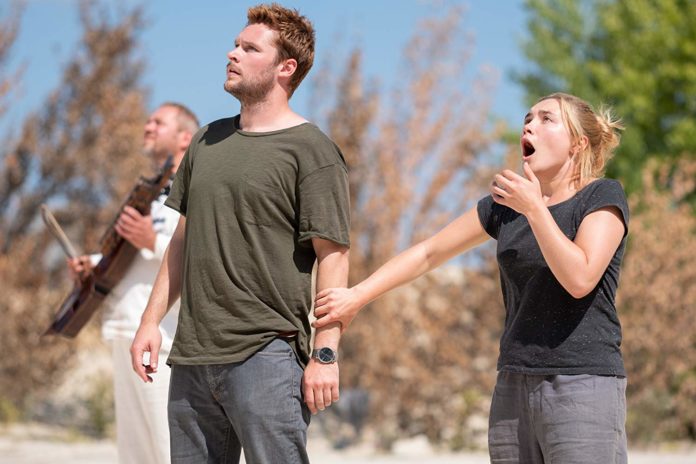
Where to even begin? Midsommar defies genre and is exceptionally difficult to wrap your head around. While some elements of the film were gory and horrific, other parts had the cinema in hysterics. Was the laughter unsettling? At times. But there were other moments which were just genuinely funny.
And yet the film begins with unbearable trauma. Florence Pugh gives an Oscar-worthy performance after her character discovers that her family has all died in a murder-suicide, executed by her mentally ill sister. To portray such extreme pain and grief seems impossible, but Pugh’s performance was completely and utterly convincing.
In grief, time moves in an unusual way and this is how Ari Aster chose to frame the film. While some scenes are painfully dragged out, others abruptly jump to the next. One example of this is when Dani is crying in the toilet of her boyfriend’s friend’s apartment and the scene splices to her hysterically crying in the plane toilet. Time jolts and shifts, held together by the unbearable trauma that Dani endures.
The rest of the film takes place in a Swedish Pagan commune. The American group are guests and observe the unique culture with an element of unease. When they bear witness to a gruesome joint suicide, it is not so much the suicide itself which is uneasy, but the fact that no one thought to warn them that it was about to happen. A feeling of “us & them” is thus prolonged, and when two of the Americans disrespect the customs of the culture, things turn nasty.
Visually, the entire movie was spectacular. The trippy mushroom scenes effectively draw the audience into a surreal and disorientated world. This surrealism lingers throughout and there is always an element of uncertainty over what is real and what is utterly insane.
The music is also remarkably effective. The singing which occupies many of the scenes seamlessly switches between beautiful and unsettling. The united cries of the commune as they harmoniously mimic the pain of their family triggers emotions which are difficult to describe. The sound of a dozen naked women making pleasure sounds as they watch one of their own make love is so bizarre to us that it is difficult not to laugh. And yet the scene is coupled with Dani’s horrendous panic attack and the Swedish women who surround her, mimicking her hysterical cries. If there was ever a desire for Dani’s grief to be louder, the anguished cries of a dozen fulfill this need.
After almost three hours of jarring and unsettling drama, the film finishes with a hut on flames and Dani’s boyfriend in a bear suit, looking out as he burns alive. The commune cries out in unison as they watch four of their people burn and Dani stands, eventually smiling.
Why Dani smiles is ambiguous and yet oddly satisfying. Throughout the feature, she is a broken shell and in this moment, she finally seems to find a slither of peace. Perhaps she has submitted herself to insanity or perhaps she has found clarity within the insanity of the commune. Ultimately, a change has taken place within her and given the magnitude of her trauma, a surreal and murderous Pagan ceremony suddenly seems like the ideal setting for recovery.
4.5/5





